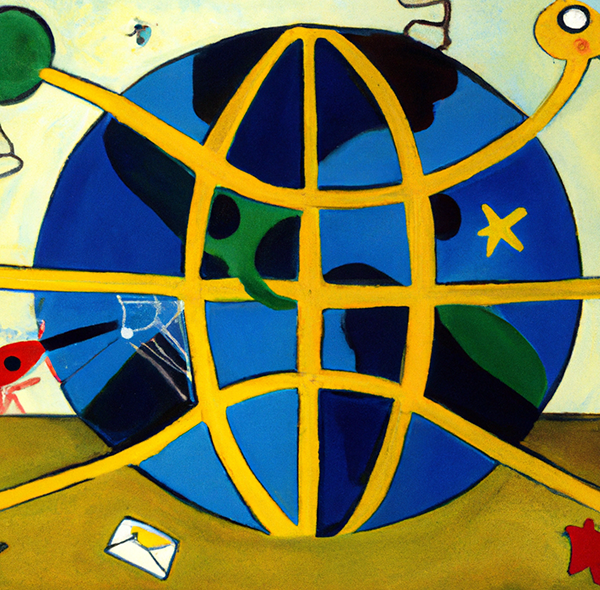
Manual Transmission
The BBC asks, “Could reading instruction manuals become a thing of the past?” Well, first off, we’re not entirely convinced that it ever was a thing of the past, as indeed they admit.
Studies show that many of us don’t bother to read the user guide. One UK survey found that one in five of us skips the manual, while a US report said it was as high as 50%.
Consumers have the luxury of throwing the manual for a new microwave or air conditioner into a kitchen drawer, but if you work industry, you really do have to.
Yet while it’s OK for a consumer to skip the user guide, this isn’t the case in the world of industry, where engineers have to know exactly how the machinery or computer system they look after works. This is especially the case if a problem arises that they need to fix as quickly as possible.
Such as a computer upgrade that crashes every computer in the world simultaneously, ruining vacations and leaving travelers stranded in Detroit for two days? That kind of problem? (Sorry, we remain bitter…) We continue.
To help such workers, Aveva has launched an AI system that can read and learn operating manuals on their behalf. In its first incarnation this AI has memorised the technical manuals for the power grids and wind turbines managed by Aveva's parent company Schneider Electric. It also continuously monitors the machinery via thousands of sensors. The idea is that the AI can imitate the expertise of senior engineers with decades of practical know-how behind them.
Does Delta Airlines know about this?
Aveva calls the system its “industrial AI assistant”, and says the aim is that it will help to compensate for a dilemma facing many businesses – an ageing workforce that is retiring and taking its hard-earned knowledge with it.
So if someone is new to their job, says Mr Herzberg, "the AI can guide them... and look at the manual for you".
Maybe the consumer could use it as well, if they can’t figure out how to set the clock on the microwave.
Park Place
Last week, we linked to a Print magazine article about branding cities. This week, Print has an article about the unveiling of the branding for a new park in Chicago. The city’s newest public park, South Side Sanctuary, features a visual identity created by Chicago’s Span Studio.
Awarded funding through the mayor’s Public Outdoor Plaza program (POP!), South Side Sanctuary emerged from a vacant lot at 47th and Martin Luther King Drive into an important retreat for the community, with space for “performance, pop-ups, and simple silence.” There is also infrastructure for sports and recreation—notably skateboarding, which I was surprised to find out is still illegal in much of Chicago.

“The flexible design of the logo, which can be arranged vertically and horizontally, mirrors the park’s flexibility to host various activities, from community events to weddings to skateboarding. The bespoke, stencil, uppercase letterforms offer a feeling of utility or building, aligning with the park’s mission of community building. The unusual uppercase descenders highlight the park’s unique topography, specifically designed for skateboarders and BMX bike riders.”
AI-Yi-Yi, Part the Infinity: A Bridge Too Far
Back when we were still using Twitter (or X or Xitter or whatever it is called now) one account we followed and regularly reposted was “the Internet of S**t,” or, basically, humorous—or horrific—examples of the “Internet of Things” gone mad. You don’t here too much about IoT anymore—now it’s all AI. And one article in Ars Technica brought back fond memories of “IoS”: “‘AI toothbrushes’ are coming for your teeth—and your data.” Indeed, we did link to a tweet about an Internet-connected toothbrush. AI takes it to the next level—and was probably the technology behind it.
Kolibree was the first company to announce a “toothbrush with artificial intelligence.” The French company debuted its Ara brush at CES 2017, with founder and CEO Thomas Serval saying, “Patented deep learning algorithms are embedded directly inside the toothbrush on a low-power processor. Raw data from the sensors runs through the processor, enabling the system to learn your habits and refine accuracy the more it’s used.”
…Kolibree now licenses its technology to Colgate-branded AI toothbrushes. The associated app, Colgate Connect, allows users to order Colgate products, sometimes at a discount. Other companies selling "AI toothbrushes" with connected e-commerce apps are Procter & Gamble's (P&G's) Oral-B, Philips, and Oclean, which announced a new tech-equipped toothbrush in July. Unlike many other toothbrushes, Oclean's X Ultra can work with Wi-Fi.
And of course these devices can be used to harvest user data, which is now the point, as there is limited scientific data that demonstrates that AI algorithms have any effect on oral health. So we’re going to make the same joke we made six years ago: hackers could access your brushing habits and blackmail you by threatening to tell your dentist.
Although perhaps artificial intelligence would be perfect for false teeth.
Wiki’d Cool
Do you rely on Wikipedia, but wish you could access it when you are not online? Sure, you could print it all out, but we’ve pointed out a few times how unwieldy that would be. But now, via Boing Boing, Wikipedia itself is selling a gadget that provides full access to Wikipedia via a WiFi hotspot.
Called Internet-in-a-Box, the device is a Raspberry Pi Zero 2 W with a 256 GB SD card. After plugging it in, up to 10 users at a time can access the information on it by entering http://box.lan in their browser.
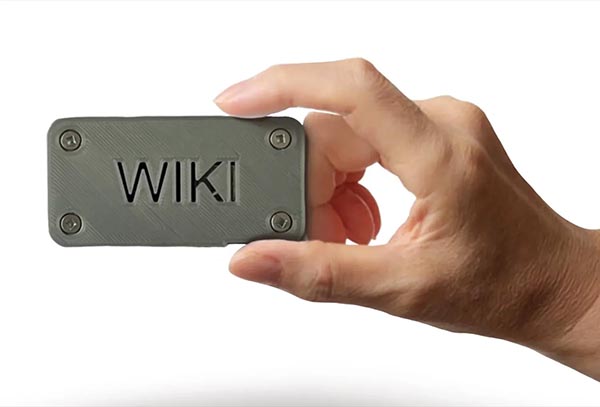
A steal at $58, although apparently it is sold out.
JPEG O’ My Heart
Consider the JPEG. Despite alternatives (GIF, PNG—our first thought, a few years ago when WebP images started appearing, was “who the heck needs another Internet image format?”), the JPEG has been the go-to image format since the dawn of the Web. Today, we take it for granted that if we send an image to someone electronically, they’ll be able to see it. That wasn’t always the case, and it was the JPEG that made image-sharing possible. Via Parametric Press, let’s travel back 38 years.
the Joint Photographic Experts Group (JPEG), a committee of experts from all over the world, was established in 1986 as a joint effort by the ISO (International Organization for Standardization) and the IEC (International Electrotechnical Commission)—two international standards organizations headquartered in Geneva, Switzerland.
JPEG, the group of people, created JPEG, a standard for digital image compression, in 1992.
If you were online in the early 1990s, you may recall that it took some effort and a few programs to decode JPEGs which are, after all, like everything else on a computer, just a series of 1s and 0s. As you know, these “bits” are grouped into sets of eight and known as “bytes.”
When you open a JPEG image on your computer, something (the browser, your operating system, or something else) has to decode the bytes to recover the original image as a list of colors that can then be displayed.
You can open a JPEG in a text editor, and this is what you’ll see:
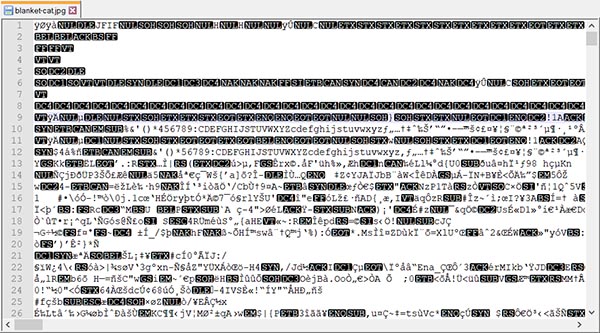
Of course a text editor will render an image as text—that’s what it’s paid to do.
To understand how a JPEG image is decoded we need to see the original signals themselves—the binary data. This can be done with a hex editor, or it can be done right here in this webpage! Below is the image next to all of its bytes, represented as decimal numbers. You can make changes to the bytes, and it will re-decode and display the new, edited image as you type.
The original site’s JPEG editor lets you edit or delete parts of the code and it will automatically show you what it does to the image.
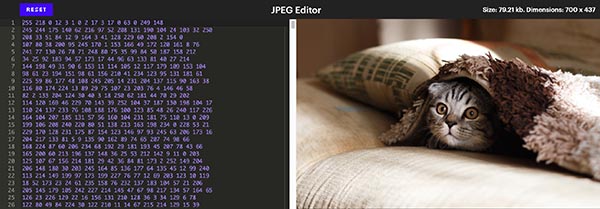
Something strange in the example above is that changing some numbers doesn’t seem to impact the image at all, while setting the 17 on line one to 0 completely ruins the image!
That it does!

Other actions, like setting the 7 on line 1988 to 254 change the color, but only for subsequent pixels.
Perhaps what’s most peculiar is that some numbers change not just the color but the shape of the image as well. Change the 70 in line 12 to 2 and look at the top row of the image to see what I mean. No matter what JPEG image you’re using, you’ll always find these mysterious checkerboard patterns when editing the bytes.
At any rate, it can be fun to play around with the innards of a JPEG file to try to understand what parts of the code affect what part of the image. Not that you will routinely want to edit images this way, of course. Anyway, click through to the original article for more than you will ever want to know about the architecture of a JPEG.
Angels in the Architecture
JPEGs aren’t the only images that can be ruined by tampering with their architecture, as restorers at the Ermita de Nuestra Señora del Mirón, a church in Soria, Spain, can easily tell you. Via the Guardian, a botched restoration—a contradiction in terms, surely—resulted in the church’s cherubim being turned into, essentially, cartoons.
Professional restorers in Spain are demanding explanations after a historic church in the north-eastern city of Soria was given a bold makeover that has left the building’s cherubim looking startled and local heritage lovers up in arms.
And decidedly less than cherubic.

The attentions lavished on the Ermita de Nuestra Señora del Mirón, which was built in 1725 on the ruins of a romanesque and gothic church, have drawn comparisons to the infamous “Ecce Homo/Monkey Christ” restoration that made headlines around the world 12 years ago.
To wit:
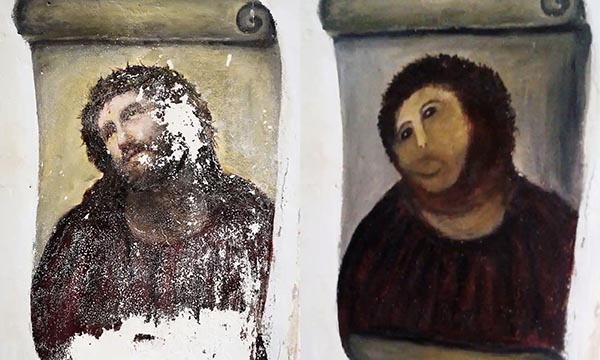
But back to the cherubs. It appears some degree of quality control needs to be implemented when these kinds of buildings are restored.
Spain’s Professional Association of Restorers and Conservators (Acre) said the work showed the need for local and regional governments to have teams of professional restorers and conservators.
“There needs to be multidisciplinary teams to avoid these kinds of efforts,” Acre said in a statement. “There needs to be weekly inspections to keep track of the works and to prevent invasive and disrespectful alterations.” The association said it had asked the heritage department of the regional government of Castilla y León for an explanation.
Not everyone hated it, though.
A spokesperson for the diocese of Osma-Soria, which is responsible for the church, said: “All I can tell you is that the works on the church were carried out with the required permissions and that some people like the end result and some don’t.”
Uh huh.
Paperlike is Like Paper
We confess to having a soft spot in our hearts for the E Ink electrophoretic display. Via Boing Boing, the latest iteration is the Paperlike Color from Dasung, a 12-in., 2560 x 1600 dpi portable color e-ink display.

It has its advantages—easy to read, not backlit, but some disadvantages especially when compared to other display technologies.
“The Kaleido display technology works by applying a color filter over a black-and-white E Ink panel, but that approach has some limitations. In black-and-white mode, E Ink's Kaleido 3 screens have a resolution of 300 ppi, but in color mode, that drops to 150 ppi. In addition, Kaleido 3 technology can also only display 4,096 colors, compared to the millions that LCD or OLED screens can display.”
A steal (!) at $849. Steal is right.
Shaper Image Catalog
Do you routinely draw things by hand that you then need to convert into vector shapes? No, nor do we, but if you are an industrial or other kind of designer, you may need to. To help, via Core 77, the Shaper Trace quickly turns hand-drawn lines into vectors.
It's a physical frame that you place around your sketch; you then use your phone to photograph the frame and your sketch, and the SVG file is captured in Shaper's app, where you can smooth and tweak it. You can then send it to your digital fabrication machine of choice, whether it's Shaper's own Origin router, a lasercutter, a CNC mill, et cetera.

Because the physical frame carries reference markings, you can shoot the sketch from any angle—no need to line your camera up dead overhead—and the software compensates. Additionally, it preserves the exact scale of your drawing. (This is handy if, for example, you're tracing a tool that you want to make a cutout for.)
The Trace was Kickstarted last year and garnered $1.1 million in pledges from 13,000+ backers.
The Graphene Conversion
Was it a good week for graphene news? It’s always a good week for graphene news! A new partnership aims to convert industrial plastic scrap into graphene. From (who else?) Graphene-Info:
Global Green USA, the American affiliate of nongovernmental organization Green Cross International, is formally endorsing and entering into a strategic partnership with Astera and the Carbon Conversion Group Inc. (CCG) as they look to convert industrial plastic scrap into high-grade graphene.
The firms say the partnership seeks to drastically reduce the landfill burden and carbon emissions. California-based Astera and CCG, a plastic recycling technology company that specializes in transforming industrial and commercial plastic scrap into synthetic graphene, graphite, hydrogen and other commodities based in Murfreesboro, Tennessee, will use technology that supports local industries, reduces reliance on imported graphene and aligns with the U.S.’ commitment to sustainability and reduced global supply chain vulnerabilities.
Eye Mouth of the Tiger
There is perhaps a lesson here for us all. From CBS News:
A Eurasian eagle owl from the Minnesota Zoo flew away from a handler during a training session and was eaten by a tiger.
This is unfortunately not an isolated incident.
It’s the second time in three years that a Eurasian eagle owl died after flying away from the zoo. In 2021, Gladys flew off a tree during a training session and was found days later on the side of the road. She was injured and the zoo’s veterinary team was unable to save her.
Guess the owls really aren’t what they seem.
For the Birds
When next you visit New York and you find yourself near the High Line elevated park on the city’s west side, don’t be surprised to see a giant bird. A pigeon, to be exact. A 16-ft. tall, aluminum pigeon named Dinosaur, to be even more exact. Says CNN:
“The name Dinosaur makes reference to the sculpture’s scale and to the pigeon’s ancestors who millions of years ago dominated the globe, as we humans do today,” [Iván Argote, the Bogotá-born, Paris-based artist] said in a statement. “The name also serves as reference to the dinosaur’s extinction. Like them, one day we won’t be around anymore, but perhaps a remnant of humanity will live on — as pigeons do — in the dark corners and gaps of future worlds. I feel this sculpture could generate an uncanny feeling of attraction, seduction and fear among the inhabitants of New York.”
Yes, who among us is not seduced by pigeons?
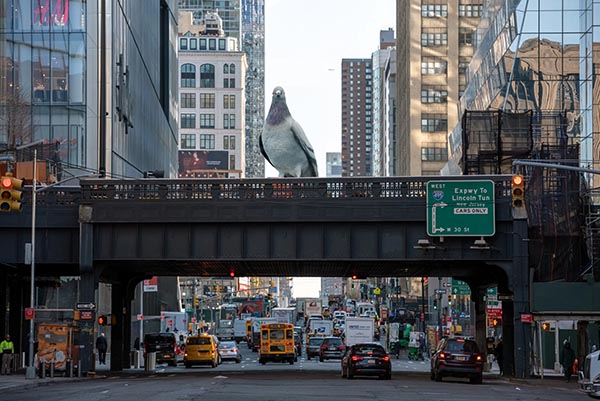
We wouldn’t want to be in one of the cars under it…. Ah, that’s just an editorial composite image. The real one is going up at the Tenth Avenue and 30th Street intersection.

You’ll probably want to avoid sitting on that plinth…
If Knead Be
Have you ever wanted to walk around smelling of fresh pretzels—specifically, an Auntie Anne’s store? Well, your wait is over, as the pretzel chain has just introduced its own fragrance—yes, a perfume redolent of fresh-made pretzels. From (who else?) Food & Wine:
According to the brand, the new scent will make you think you're smothering yourself in a warm, freshly made pretzel with "notes of buttery dough, salt, and a hint of sweetness." As Auntie Anne's added, "Each spritz evokes the experience of passing an Auntie Anne's store and inhaling the nostalgic aroma of their pretzels."
As silly as this may be, we do admire the name of the scent: Knead.
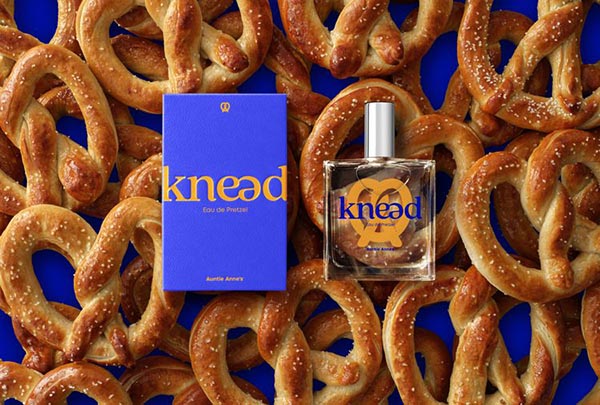
In honor of the new scent's launch, Auntie Anne's is opening New York's first "Pretzel Parfumerie" for one very special day on August 13. The perfumery, located at 433 Broadway in Soho, New York, will be open from 12:00 p.m. to 7:00 p.m. Fans of the brand came come through to enjoy the first spritzes of the Knead fragrance, and visitors will also receive a complimentary tote bag along with an Auntie Anne’s Original Pretzel (while supplies last, naturally). Those customers who do purchase a bottle of Knead will also get the chance to take home some additional swag.
Oh, they’ll get that chance, will they? How surprising.
If you are interested, Knead will be mass-released on August 14 in 1-ounce and 3.4-ounce bottles for $25 and $45, respectively, via auntieannes.com/knead. Don’t be surprised if strangers come up and slather you with mustard.
This Week in Printing, Publishing, and Media History
August 5
1735: New York Weekly Journal writer John Peter Zenger is acquitted of seditious libel against the royal governor of New York, on the basis that what he had published was true.
1850: French short story writer, novelist, and poet Guy de Maupassant born.
1914: In Cleveland, Ohio, the first electric traffic light is installed.
1930: American pilot, engineer, and astronaut Neil Armstrong born.
1957: American Bandstand, a show dedicated to the teenage “baby-boomers” by playing the songs and showing popular dances of the time, debuts on the ABC television network.
2019: American author, Pulitzer Prize winner, and Nobel laureate Toni Morrison dies (b. 1931).
August 6
1809: English poet Alfred, Lord Tennyson, born.
1926: In New York City, the Warner Bros.’ Vitaphone system premieres with the movie Don Juan starring John Barrymore.
1956: After going bankrupt in 1955, the American broadcaster DuMont Television Network makes its final broadcast, a boxing match from St. Nicholas Arena in New York in the Boxing from St. Nicholas Arenaseries.
1991: Tim Berners-Lee releases files describing his idea for the World Wide Web. WWW debuts as a publicly available service on the Internet. (Too bad it never caught on.)
August 7
1834: French weaver and inventor, inventor of the Jacquard loom Joseph Marie Jacquard dies (b. 1752).
1926: American puppeteer, voice actor, and singer Stan Freberg, born.
1928: Canadian-American magician and author James Randi born.
1944: IBM dedicates the first program-controlled calculator, the Automatic Sequence Controlled Calculator (known best as the Harvard Mark I).
1959: The Lincoln Memorial design on the U.S. penny goes into circulation. It replaces the “sheaves of wheat” design, and was minted until 2008.
1981: The Washington Star ceases all operations after 128 years of publication.
August 8
1876: Thomas Edison receives a patent for his mimeograph.
1969: At a crosswalk in London, photographer Iain Macmillan takes the photo that becomes the cover image of the Beatles' album Abbey Road, leading to nearly five decades of Beatles fans nearly being run down on that same crosswalk trying to imitate it.
2018-08-10-AtW-abbey road
August 9
1776: Italian physicist and chemist Amedeo Avogadro born. (We’ve got his number.)
1854: Henry David Thoreau publishes Walden.
1892: Thomas Edison receives a patent for a two-way telegraph.
1930: Betty Boop makes her cartoon debut in Dizzy Dishes.
1944: The United States Forest Service and the Wartime Advertising Council release posters featuring Smokey Bear for the first time.
1962: German-born Swiss poet, novelist, and painter, Nobel Prize laureate Hermann Hesse dies (b. 1877).
1967: English author and playwright Joe Orton dies (b. 1933).
August 10
1793: The Musée du Louvre is officially opened in Paris, France.
1846: The Smithsonian Institution is chartered by the United States Congress after James Smithson donates $500,000.
1889: American game designer and creator of Monopoly Charles Darrow born.
1948: Smile! Candid Camera makes its television debut after being on radio for a year as Candid Microphone.
August 11
1942: Actress Hedy Lamarr (not Hedley) and composer George Antheil receive a patent for a Frequency-hopping spread spectrum communication system that later became the basis for modern technologies in wireless telephones and Wi-Fi.
1946: American journalist and author Marilyn vos Savant born.
1950: Apple co-founder Steve Wozniak born.




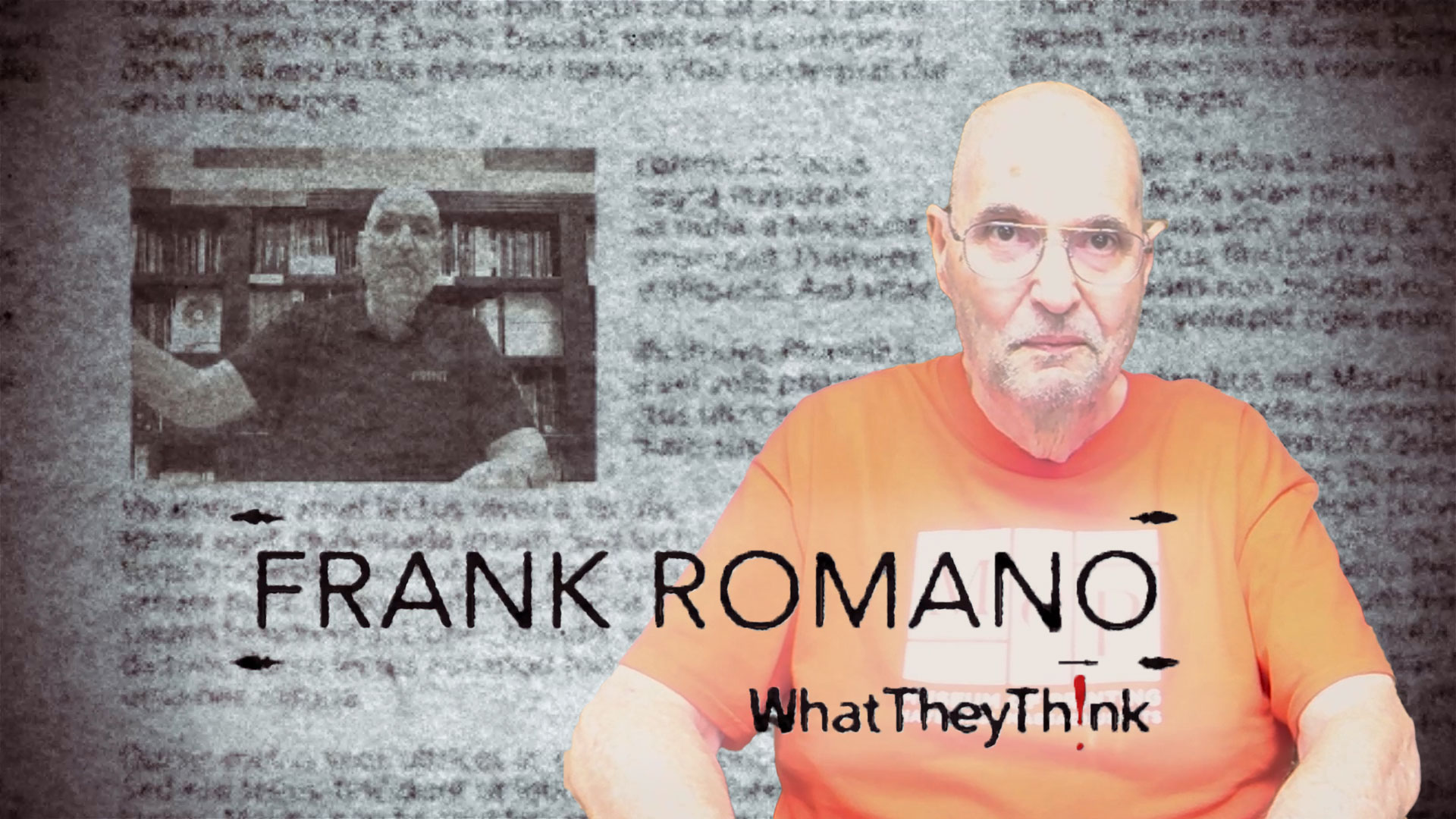




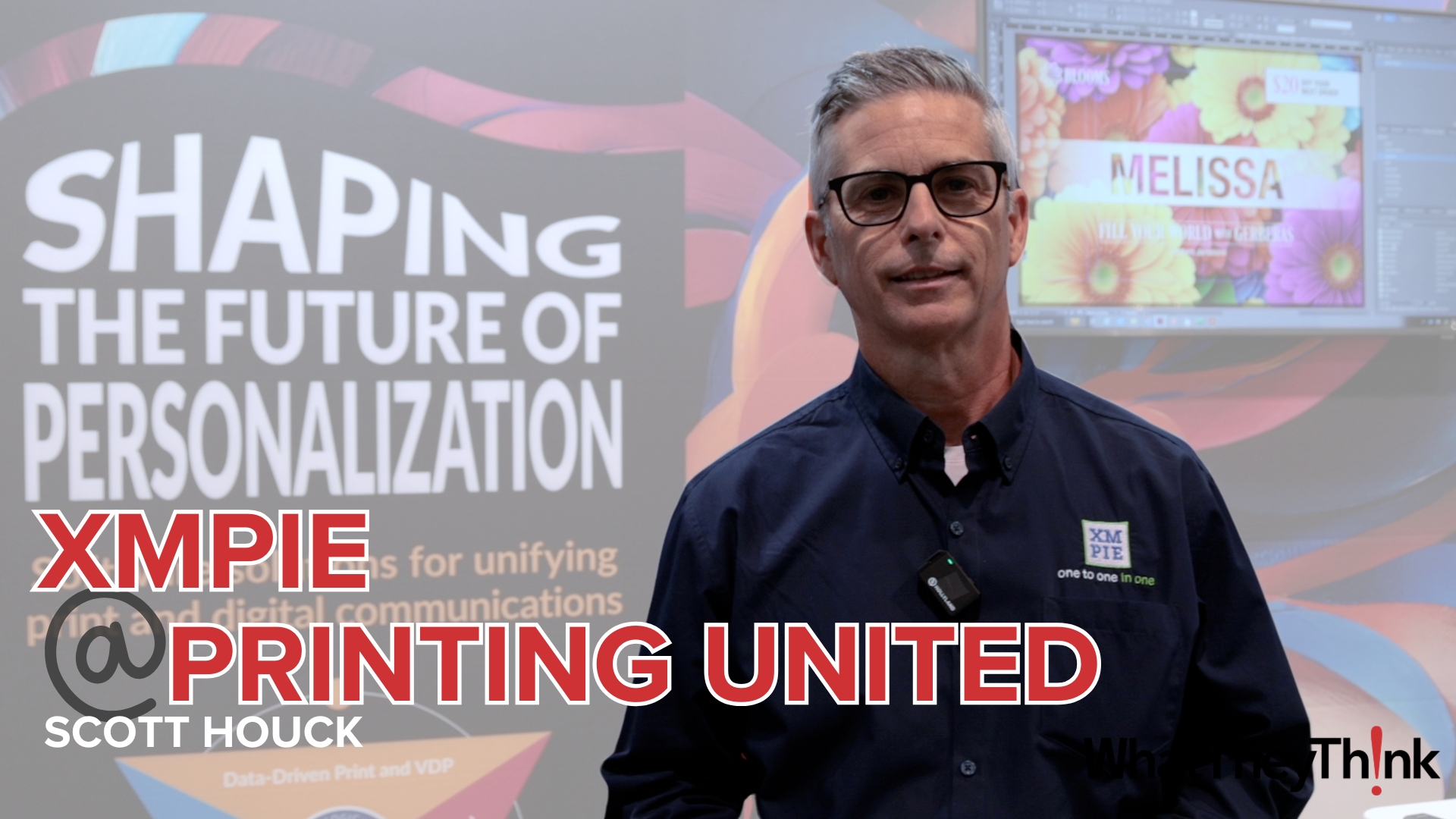





Discussion
Only verified members can comment.